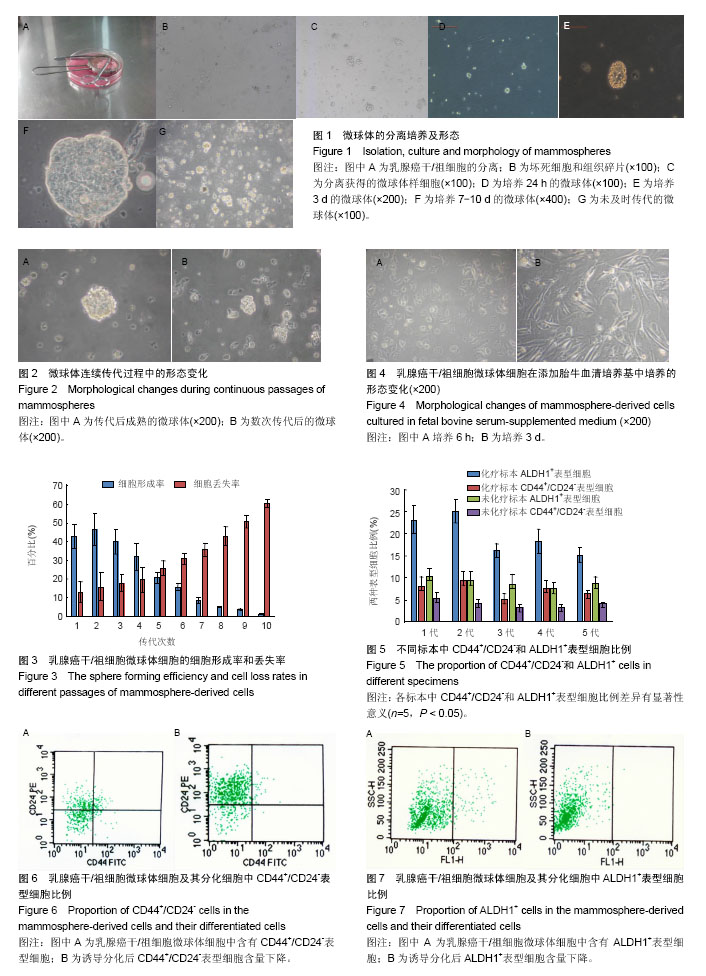| [1] 江泽飞,许凤锐.乳腺癌分子分型对治疗的影响[J]. 中华普外科手术学杂志:电子版, 2015,9(6):12-15.[2] 赵毅, 邓鑫. 乳腺癌分子分型与治疗策略[J]. 中国实用外科杂志, 2015, 35(7):704-708.[3] Alluri P, Newman LA. Basal-like and triple-negative breast cancers: searching for positives among many negatives. Surg Oncol Clin N Am. 2014;23(3):567-577.[4] Curtis C, Shah SP, Chin SF, et al. The genomic and transcriptomic architecture of 2,000 breast tumours reveals novel subgroups. Nature. 2012;486(7403):346-352.[5] Owens TW, Naylor MJ. Breast cancer stem cells. Front Physiol. 2013;4:225.[6] 陈元文,乔正荣,吴诚义,等. 新辅助化疗后乳腺导管癌干/祖细胞克隆形成观察[J].检验医学与临床, 2014,11(1):8-10.[7] 郭崇勇,李克,周凌,等.长程多柔比星化疗富集乳腺肿瘤干细胞[J]. 肿瘤, 2012, 32(1):27-31.[8] 董华英,吴诚义,陈元文.乳腺癌新辅助化疗后的癌干细胞分离培养[J]. 第三军医大学学报, 2010, 32(20):2172-2176.[9] Visvader JE, Stingl J. Mammary stem cells and the differentiation hierarchy: current status and perspectives. Genes Dev. 2014;28(11):1143-1158.[10] Sreekumar A, Roarty K, Rosen JM. The mammary stem cell hierarchy: a looking glass into heterogeneous breast cancer landscapes. Endocr Relat Cancer. 2015;22(6):T161-176.[11] Oakes SR, Gallego-Ortega D, Ormandy CJ. The mammary cellular hierarchy and breast cancer. Cell Mol Life Sci. 2014;71(22):4301-4324.[12] Ponti D, Costa A, Zaffaroni N, et al. Isolation and in vitro propagation of tumorigenic breast cancer cells with stem/progenitor cell properties. Cancer Res. 2005;65(13): 5506-5511.[13] Cho N. Molecular subtypes and imaging phenotypes of breast cancer. Ultrasonography. 2016;35(4):281-288.[14] Krüger K, Wik E, Knutsvik G, et al. Expression of Nestin associates with BRCA1 mutations, a basal-like phenotype and aggressive breast cancer. Sci Rep. 2017;7(1):1089.[15] Leidy J, Khan A, Kandil D. Basal-like breast cancer: update on clinicopathologic, immunohistochemical, and molecular features. Arch Pathol Lab Med. 2014;138(1):37-43.[16] Sato T, Stange DE, Ferrante M, et al. Long-term expansion of epithelial organoids from human colon, adenoma, adenocarcinoma, and Barrett's epithelium. Gastroenterology. 2011;141(5):1762-1772.[17] 陈元文.基底样乳腺癌与管腔A乳腺癌干/祖细胞的表型和功能研究[D]. 重庆:重庆医科大学, 2010.[18] 董华英,吴诚义,陈元文.化疗后乳腺癌组织中干细胞微球体的分离、培养及鉴定[J]. 吉林大学学报:医学版, 2011,37(1):163-167.[19] Dey D, Saxena M, Paranjape AN, et al. Phenotypic and functional characterization of human mammary stem/progenitor cells in long term culture. PLoS One. 2009;4(4):e5329.[20] 陈元文,吴诚义,陈鑫,等.长程无血清培养人乳腺癌细胞球的生物学特性[J]. 肿瘤, 2010, 30(4):283-287.[21] 陈元文,吴诚义,董华英,等. 基底样乳腺癌和管腔A乳腺癌干祖细胞的生物学行为比较[J]. 中国肿瘤临床, 2010, 37(21): 1209-1213.[22] 陈元文,吴诚义,董华英. 基底样乳腺癌与管腔A乳腺癌干/祖细胞的表型分析[J]. 检验医学与临床, 2014,11(2):165-167.[23] Al-Hajj M, Wicha MS, Benito-Hernandez A, et al. Prospective identification of tumorigenic breast cancer cells. Proc Natl Acad Sci U S A. 2003;100(7):3983-3988.[24] Ginestier C, Hur MH, Charafe-Jauffret E, et al. ALDH1 is a marker of normal and malignant human mammary stem cells and a predictor of poor clinical outcome. Cell Stem Cell. 2007;1(5):555-567.[25] Holah NS, Aiad HA, Asaad NY, et al. Evaluation of the Role of ALDH1 as Cancer Stem Cell Marker in Colorectal Carcinoma: An Immunohistochemical Study. J Clin Diagn Res. 2017;11(1): EC17-EC23.[26] Wang J, Wang L, Ho CT, et al. Garcinol from Garcinia indica Downregulates Cancer Stem-like Cell Biomarker ALDH1A1 in Nonsmall Cell Lung Cancer A549 Cells through DDIT3 Activation. J Agric Food Chem. 2017;65(18):3675-3683.[27] Kuroda T, Hirohashi Y, Torigoe T, et al. ALDH1-high ovarian cancer stem-like cells can be isolated from serous and clear cell adenocarcinoma cells, and ALDH1 high expression is associated with poor prognosis. PLoS One. 2013;8(6): e65158.[28] Nishida S, Hirohashi Y, Torigoe T, et al. Prostate cancer stem-like cells/cancer-initiating cells have an autocrine system of hepatocyte growth factor. Cancer Sci. 2013;104(4): 431-436.[29] Lu H, Chen I, Shimoda LA, et al. Chemotherapy-Induced Ca2+ Release Stimulates Breast Cancer Stem Cell Enrichment. Cell Rep. 2017;18(8):1946-1957.[30] Achuthan S, Santhoshkumar TR, Prabhakar J, et al. Drug-induced senescence generates chemoresistant stemlike cells with low reactive oxygen species. J Biol Chem. 2011; 286(43): 37813-37829.[31] O'Brien SK, Chen L, Zhong W, et al. Breast cancer cells respond differentially to modulation of TGFβ2 signaling after exposure to chemotherapy or hypoxia. Cancer Res. 2015;75(21):4605-4616. |
.jpg)

.jpg)